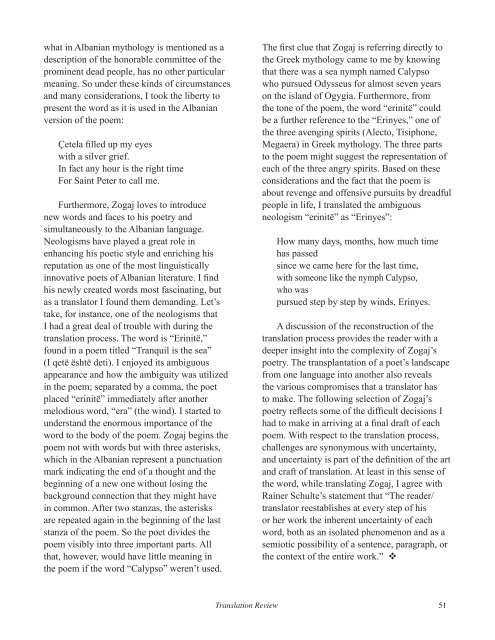Table of contents - The University of Texas at Dallas
Table of contents - The University of Texas at Dallas
Table of contents - The University of Texas at Dallas
You also want an ePaper? Increase the reach of your titles
YUMPU automatically turns print PDFs into web optimized ePapers that Google loves.
wh<strong>at</strong> in Albanian mythology is mentioned as a<br />
description <strong>of</strong> the honorable committee <strong>of</strong> the<br />
prominent dead people, has no other particular<br />
meaning. So under these kinds <strong>of</strong> circumstances<br />
and many consider<strong>at</strong>ions, I took the liberty to<br />
present the word as it is used in the Albanian<br />
version <strong>of</strong> the poem:<br />
Çetela filled up my eyes<br />
with a silver grief.<br />
In fact any hour is the right time<br />
For Saint Peter to call me.<br />
Furthermore, Zogaj loves to introduce<br />
new words and faces to his poetry and<br />
simultaneously to the Albanian language.<br />
Neologisms have played a gre<strong>at</strong> role in<br />
enhancing his poetic style and enriching his<br />
reput<strong>at</strong>ion as one <strong>of</strong> the most linguistically<br />
innov<strong>at</strong>ive poets <strong>of</strong> Albanian liter<strong>at</strong>ure. I find<br />
his newly cre<strong>at</strong>ed words most fascin<strong>at</strong>ing, but<br />
as a transl<strong>at</strong>or I found them demanding. Let’s<br />
take, for instance, one <strong>of</strong> the neologisms th<strong>at</strong><br />
I had a gre<strong>at</strong> deal <strong>of</strong> trouble with during the<br />
transl<strong>at</strong>ion process. <strong>The</strong> word is “Erinitë,”<br />
found in a poem titled “Tranquil is the sea”<br />
(I qetë është deti). I enjoyed its ambiguous<br />
appearance and how the ambiguity was utilized<br />
in the poem; separ<strong>at</strong>ed by a comma, the poet<br />
placed “erinitë” immedi<strong>at</strong>ely after another<br />
melodious word, “era” (the wind). I started to<br />
understand the enormous importance <strong>of</strong> the<br />
word to the body <strong>of</strong> the poem. Zogaj begins the<br />
poem not with words but with three asterisks,<br />
which in the Albanian represent a punctu<strong>at</strong>ion<br />
mark indic<strong>at</strong>ing the end <strong>of</strong> a thought and the<br />
beginning <strong>of</strong> a new one without losing the<br />
background connection th<strong>at</strong> they might have<br />
in common. After two stanzas, the asterisks<br />
are repe<strong>at</strong>ed again in the beginning <strong>of</strong> the last<br />
stanza <strong>of</strong> the poem. So the poet divides the<br />
poem visibly into three important parts. All<br />
th<strong>at</strong>, however, would have little meaning in<br />
the poem if the word “Calypso” weren’t used.<br />
<strong>The</strong> first clue th<strong>at</strong> Zogaj is referring directly to<br />
the Greek mythology came to me by knowing<br />
th<strong>at</strong> there was a sea nymph named Calypso<br />
who pursued Odysseus for almost seven years<br />
on the island <strong>of</strong> Ogygia. Furthermore, from<br />
the tone <strong>of</strong> the poem, the word “erinitë” could<br />
be a further reference to the “Erinyes,” one <strong>of</strong><br />
the three avenging spirits (Alecto, Tisiphone,<br />
Megaera) in Greek mythology. <strong>The</strong> three parts<br />
to the poem might suggest the represent<strong>at</strong>ion <strong>of</strong><br />
each <strong>of</strong> the three angry spirits. Based on these<br />
consider<strong>at</strong>ions and the fact th<strong>at</strong> the poem is<br />
about revenge and <strong>of</strong>fensive pursuits by dreadful<br />
people in life, I transl<strong>at</strong>ed the ambiguous<br />
neologism “erinitë” as “Erinyes”:<br />
How many days, months, how much time<br />
has passed<br />
since we came here for the last time,<br />
with someone like the nymph Calypso,<br />
who was<br />
pursued step by step by winds, Erinyes.<br />
A discussion <strong>of</strong> the reconstruction <strong>of</strong> the<br />
transl<strong>at</strong>ion process provides the reader with a<br />
deeper insight into the complexity <strong>of</strong> Zogaj’s<br />
poetry. <strong>The</strong> transplant<strong>at</strong>ion <strong>of</strong> a poet’s landscape<br />
from one language into another also reveals<br />
the various compromises th<strong>at</strong> a transl<strong>at</strong>or has<br />
to make. <strong>The</strong> following selection <strong>of</strong> Zogaj’s<br />
poetry reflects some <strong>of</strong> the difficult decisions I<br />
had to make in arriving <strong>at</strong> a final draft <strong>of</strong> each<br />
poem. With respect to the transl<strong>at</strong>ion process,<br />
challenges are synonymous with uncertainty,<br />
and uncertainty is part <strong>of</strong> the definition <strong>of</strong> the art<br />
and craft <strong>of</strong> transl<strong>at</strong>ion. At least in this sense <strong>of</strong><br />
the word, while transl<strong>at</strong>ing Zogaj, I agree with<br />
Rainer Schulte’s st<strong>at</strong>ement th<strong>at</strong> “<strong>The</strong> reader/<br />
transl<strong>at</strong>or reestablishes <strong>at</strong> every step <strong>of</strong> his<br />
or her work the inherent uncertainty <strong>of</strong> each<br />
word, both as an isol<strong>at</strong>ed phenomenon and as a<br />
semiotic possibility <strong>of</strong> a sentence, paragraph, or<br />
the context <strong>of</strong> the entire work.” v<br />
Transl<strong>at</strong>ion Review 51

















